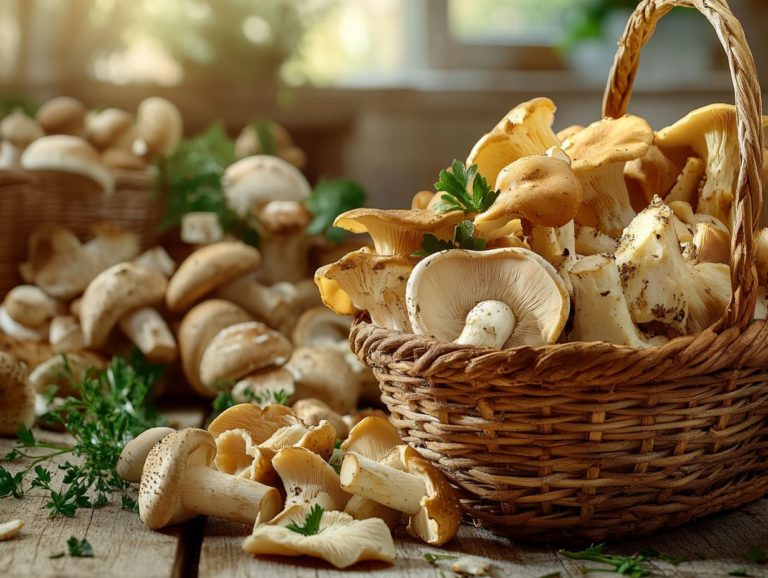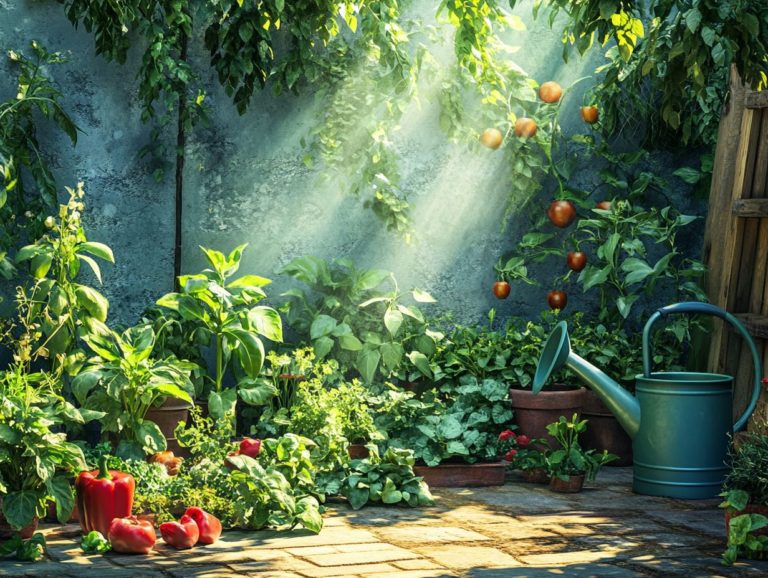Foraging for Edible Plants in Your Region
Foraging offers an exhilarating and fulfilling opportunity to connect with nature while uncovering delicious, nutritious foods right in your own backyard. This guide will walk you through the essentials of foraging, including the significance of seasonal foraging, beginning with what it entails and why it deserves your attention.
You ll also learn how to identify common edible plants, prioritize safety during your foraging adventures, and adopt sustainable practices that respect the environment through the use of foraging tools and guidebooks. Explore tips on preparing your foraged treasures and discover the myriad benefits of foraging, such as enhancing your nutritional value, not just for yourself, but for your community as well.
Embrace the wild bounty that surrounds you, including the delightful flavors of wild herbs and edible flowers!
Contents
- Key Takeaways:
- The Basics of Foraging
- Identifying Edible Plants
- Foraging Safety
- Sustainable Foraging Practices
- Preparing and Cooking Foraged Plants
- Foraging as a Sustainable Lifestyle: A Journey of Nature Connection and Culinary Exploration
- Frequently Asked Questions
- 1. What are the benefits of foraging for edible plants in my region?
- 2. How do I know which plants are safe to eat when foraging?
- 3. Can I forage for edible plants in public parks or on private property?
- 4. What are some common edible plants found in my region?
- 5. Are there any precautions I should take when foraging for edible plants?
- 6. What are some creative ways to use foraged edible plants in my cooking?
Key Takeaways:
- Foraging is the act of gathering food from wild plants. It s a rewarding way to connect with nature.
- Identifying edible plants correctly is vital for safety. Always consult local experts or field guides.
- Sustainable foraging means taking only what you need and respecting the land.

The Basics of Foraging
Foraging is the art of seeking out and gathering wild food resources think delectable edible plants and mushrooms in the great outdoors, from lush forests to open fields and even your own backyard.
This age-old practice unlocks exciting flavors and experiences! It nurtures a profound connection with nature and encourages sustainable outdoor activities.
By immersing yourself in foraging, you can elevate your cooking experiences, revel in the delights of seasonal harvests, and gain invaluable insights into local ecosystems and biodiversity.
What is Foraging and Why Do It?
Foraging invites you to gather wild food, from edible plants to mushrooms, allowing you to connect deeply with nature while honing essential survival skills. To enhance your foraging experience, consider learning what to know about seasonal foraging in your area.
This practice enriches your diet with nutrient-dense foods and sparks culinary creativity, inspiring you to craft unique dishes that store-bought ingredients simply can t match.
You may find yourself drawn to community groups where you can share tips, learn from seasoned foragers, and exchange recipes that celebrate the seasonal bounty. With educational resources at your fingertips, you’ll gain the knowledge on how to identify wild edibles by region, fostering a sense of enablement and appreciation for the natural world.
This journey cultivates a collective spirit, strengthening local bonds among those who share your passion for sustainable living.
Identifying Edible Plants
Identifying edible plants is essential for safe foraging, allowing you to differentiate between common, tasty options and potentially poisonous varieties that could threaten your health. For more information, refer to the guide to seasonal foraging in your area.
Mastering this skill, aided by foraging tools and guidebooks, not only enhances your foraging experience but also ensures that your cooking experiences remain both enjoyable and safe.
Common Edible Plants in Different Regions
Common edible plants vary by region, revealing a rich tapestry of biodiversity and culinary possibilities. To truly appreciate this diversity, learn how to master foraging in your region. From dandelions and chickweed to wild herbs and edible flowers, you can discover a world of flavors nestled in diverse landscapes.
These plants not only enhance your meals with nutrition but also play an essential role in local ecosystems. Consider wild garlic, which flourishes in woodlands, offering flavor along with impressive health benefits, including being good for fighting germs.
In coastal areas, seaweed varieties are prized for their rich iodine content, underscoring the importance of understanding your specific environment.
By embracing sustainable foraging practices, you help ensure that these natural treasures remain abundant for future generations. This approach fosters a deeper connection to the land and cultivates a respect for its offerings. Therefore, if you re interested in exploring edible plants, approach foraging with mindfulness and knowledge to protect these vital habitats.
How to Properly Identify Plants

To identify plants correctly, use various methods. Resources like field guides, foraging tools, and cutting-edge plant identification apps can help you safely select edible species.
Utilizing these resources allows you to appreciate the remarkable diversity of flora while minimizing the risks of misidentification. Regularly observing traits like leaf shape, flower structure, and growth habits is crucial for honing your skills.
Engage with local botanical groups to share experiences. This can deepen your knowledge of wild plants.
Pay close attention to a plant’s habitat; it can guide you in understanding which species thrive in specific environments. By blending technology with traditional techniques, you cultivate a deeper connection to nature while ensuring that your foraging practices are both safe and rewarding.
Foraging Safety
Foraging safety is essential when gathering wild food. It requires a commitment to strict guidelines and a thorough understanding of plants that can make you sick.
Staying informed helps you prevent health risks associated with poisonous plants. Prioritizing safety ensures that your foraging adventures are enjoyable and secure.
Precautions and Guidelines
Precautions and guidelines for foraging are vital for your journey in nature. They include thorough plant identification, understanding local ecosystems, and adhering to established foraging rules.
These measures ensure a safe and sustainable experience. Taking specific precautions is crucial for anyone who enjoys foraging.
Steer clear of areas known for pollution, like roadsides or locations near industrial sites, as these often harbor contaminated plants. Recognizing signs of plant toxicity, such as unusual colors or textures, can safeguard you against adverse health effects.
Engaging with the community enhances your knowledge base. Learning from seasoned foragers contributes to safer practices, allowing you to fully embrace the joys of foraging while respecting nature.
Sustainable Foraging Practices
Embracing sustainable foraging practices is vital for preserving natural resources and ensuring the ongoing availability of wild ingredients. It’s about adopting responsible harvesting techniques and championing environmental stewardship.
By doing so, you not only enjoy the bounty of nature but also play a crucial role in protecting it for future generations.
How to Forage Responsibly
Foraging responsibly means adhering to guidelines that protect wild edibles. Avoid endangered plant species and their habitats to ensure that future generations can relish the joys of foraging.
Recognizing the delicate balance of nature is crucial; never take more than you need. Allow populations to thrive and regenerate. Techniques like rotating your foraging spots and being mindful of seasonal growth cycles play a significant role in sustainability.
Engage in community foraging initiatives and share experiences on social media. This cultivates shared knowledge and respect for nature, uniting people while underscoring the importance of conservation.
Participate in workshops or join local groups to learn best practices and discover new edible varieties. This sharpens your skills and helps forge a supportive community dedicated to the art of responsible foraging.
Preparing and Cooking Foraged Plants

Preparing and cooking with foraged plants can be an extraordinary culinary journey. You’ll discover a rich array of flavors and nutrients that elevate traditional recipes while inviting you to explore top local edibles to forage in your area and new techniques.
Embrace the adventure and discover the unique tastes that nature has to offer!
Recipes and Tips
Delicious recipes featuring foraged ingredients can transform simple meals into extraordinary culinary adventures. They showcase the remarkable versatility of foraging for edible plants and wild herbs.
As you explore the great outdoors, take a moment to appreciate the bounty nature offers. Edible landscapes rich in biodiversity present vibrant flavors, like wild garlic, the delicate sweetness of elderflowers, and the earthy richness of foraged mushrooms. These can elevate even the simplest dishes to new heights.
Incorporating unique ingredients like wild herbs and edible flowers enhances flavor and infuses your cooking with originality. Whether crafting a refreshing salad adorned with dandelion greens or a rustic wild mushroom risotto, the possibilities for creativity are truly limitless.
Dive into your adventurous spirit, experiment with your foraged treasures, and turn everyday meals into unforgettable feasts.
Foraging as a Sustainable Lifestyle: A Journey of Nature Connection and Culinary Exploration
Embracing foraging as a sustainable lifestyle enriches your connection to nature while cultivating community engagement. Through shared outdoor experiences, you gain appreciation for wild fruits and herbs. This forges bonds with others who share your passion for the great outdoors.
Benefits for the Environment and Community
Foraging offers remarkable benefits to both the environment and your community. It enhances biodiversity, supports local ecosystems, and fosters appreciation for nature s diverse offerings.
Engaging in foraging practices helps you connect more deeply with the land. You gain insight into seasonal cycles and the delicate balance of local habitats. As you gather findings, sharing discoveries with others creates a vibrant exchange of knowledge and techniques that strengthen community bonds.
Working together enriches local food culture and raises awareness about how to harvest sustainably. This ensures future generations can enjoy a rich array of wild edibles.
By embracing these practices, you cultivate a stronger sense of stewardship for the natural world. You inspire those around you to value and protect the environment.
Frequently Asked Questions
1. What are the benefits of foraging for edible plants in my region?

Foraging for edible plants in your region provides numerous benefits, including access to fresh, nutrient-rich food, cost savings on groceries, and a deeper connection to your local environment. To enhance your foraging experience, consider identifying edible plants in your region.
2. How do I know which plants are safe to eat when foraging?
Researching and learning about plants in your region is crucial before foraging. For those interested in identifying wild edibles in your local area, look for reputable sources and field guides to identify edible plants. Always double-check with an expert if you are unsure.
3. Can I forage for edible plants in public parks or on private property?
Always respect private property and follow local regulations when foraging. Many public parks have designated areas for foraging, but checking with park officials is essential. If uncertain about the rules, it’s best to forage on your own property or on public land.
4. What are some common edible plants found in my region?
The types of edible plants available depend on your climate and geography. For guidance on exploring these options, check out how to forage edible plants safely. Common examples include dandelion greens, wild berries, and various types of mushrooms.
5. Are there any precautions I should take when foraging for edible plants?
Always wear protective clothing, such as gloves and long sleeves, to avoid contact with poisonous plants. Thoroughly wash all foraged plants before consuming them.
6. What are some creative ways to use foraged edible plants in my cooking?
Foraged edible plants can add unique flavors and textures to your dishes. Consider using wild herbs in marinades or sauces, incorporating wild berries into baked goods, or adding foraged greens to salads or stir-fries.
Ready to explore the world of foraged ingredients? Get out there and start your adventure today!






